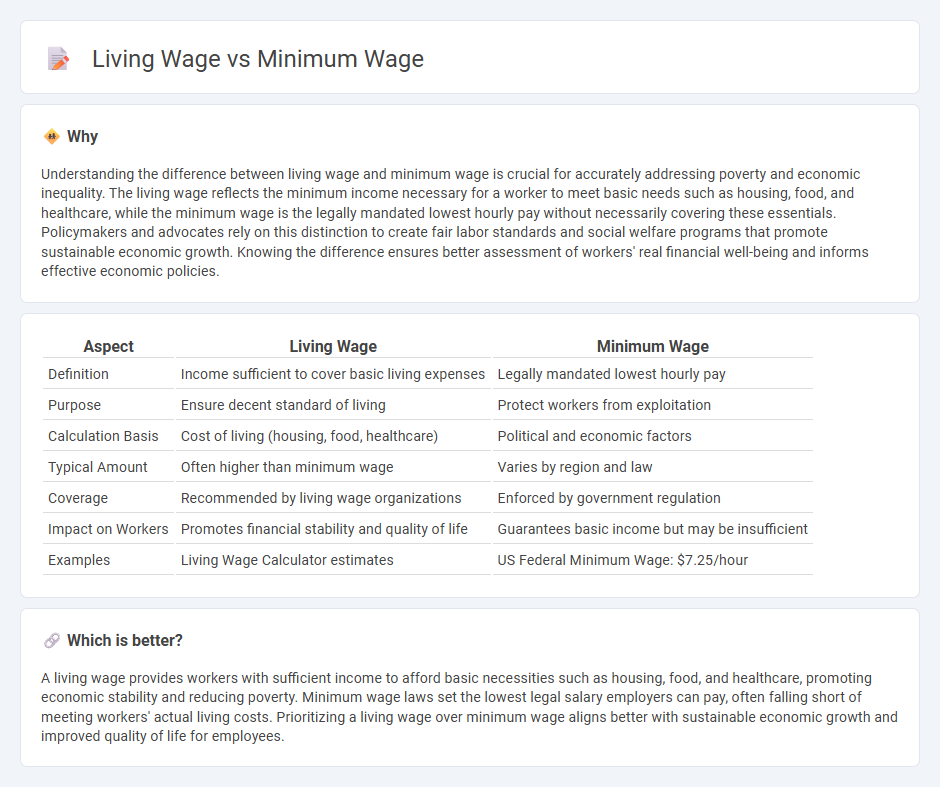
A living wage reflects the income necessary to meet basic needs like housing, food, and healthcare, while the minimum wage is the legally mandated lowest hourly pay. Many argue the minimum wage often falls short of ensuring a decent standard of living, sparking debates on economic fairness and policy reforms. Explore how living wage initiatives impact poverty reduction and economic stability.
Why it is important
Understanding the difference between living wage and minimum wage is crucial for accurately addressing poverty and economic inequality. The living wage reflects the minimum income necessary for a worker to meet basic needs such as housing, food, and healthcare, while the minimum wage is the legally mandated lowest hourly pay without necessarily covering these essentials. Policymakers and advocates rely on this distinction to create fair labor standards and social welfare programs that promote sustainable economic growth. Knowing the difference ensures better assessment of workers' real financial well-being and informs effective economic policies.
Comparison Table
| Aspect | Living Wage | Minimum Wage |
|---|---|---|
| Definition | Income sufficient to cover basic living expenses | Legally mandated lowest hourly pay |
| Purpose | Ensure decent standard of living | Protect workers from exploitation |
| Calculation Basis | Cost of living (housing, food, healthcare) | Political and economic factors |
| Typical Amount | Often higher than minimum wage | Varies by region and law |
| Coverage | Recommended by living wage organizations | Enforced by government regulation |
| Impact on Workers | Promotes financial stability and quality of life | Guarantees basic income but may be insufficient |
| Examples | Living Wage Calculator estimates | US Federal Minimum Wage: $7.25/hour |
Which is better?
A living wage provides workers with sufficient income to afford basic necessities such as housing, food, and healthcare, promoting economic stability and reducing poverty. Minimum wage laws set the lowest legal salary employers can pay, often falling short of meeting workers' actual living costs. Prioritizing a living wage over minimum wage aligns better with sustainable economic growth and improved quality of life for employees.
Connection
Living wage and minimum wage are interconnected as both aim to ensure fair compensation for workers, but living wage reflects the actual cost of living required for basic needs, while minimum wage is the legally mandated lowest pay. Economists analyze the gap between minimum wage and living wage to assess poverty reduction effectiveness and labor market policies. Adjusting minimum wage towards the living wage supports economic stability by increasing purchasing power and reducing income inequality.
Key Terms
Purchasing Power
Minimum wage often fails to keep up with inflation, resulting in diminished purchasing power for workers despite nominal increases. A living wage, calculated based on the actual cost of essential goods and services like housing, food, and healthcare, ensures that workers maintain sufficient purchasing power to cover basic living expenses. Explore how different regions address this gap to understand the impact on economic stability and quality of life.
Cost of Living
The minimum wage often falls short of covering the true cost of living, which includes housing, food, healthcare, and transportation expenses. Living wage calculations take these essential costs into account, aiming to ensure workers earn enough to maintain a decent standard of living without financial stress. Explore how aligning wages with living costs can promote economic stability and improve quality of life.
Poverty Line
The minimum wage is a legally mandated baseline that often falls below the living wage, which accounts for basic needs such as housing, food, healthcare, and transportation to uplift individuals above the poverty line. Many workers earning minimum wage remain entrenched in poverty due to inflation and regional cost-of-living disparities, highlighting a critical gap in social policy frameworks. Explore detailed comparisons and policy implications to understand how living wage standards can more effectively combat poverty.
Source and External Links
USA Minimum Wage Hike 2025: Check Updated Rates for Every State! - The U.S. federal minimum wage is $7.25/hour since 2009, but may increase federally in May 2025, with many states having higher rates adjusted for local living costs.
Minimum wage - Wikipedia - Minimum wage is the legally mandated lowest pay rate for labor, intended to prevent worker exploitation and improve living standards, though it varies widely by region and economic factors globally.
Minimum Wage - Connecticut - 211 and eLibrary - Connecticut's minimum wage rose to $16.35/hour on January 1, 2025, indexed annually to the federal Employment Cost Index, with a lower rate allowed for minors during their first 90 days.
 dowidth.com
dowidth.com